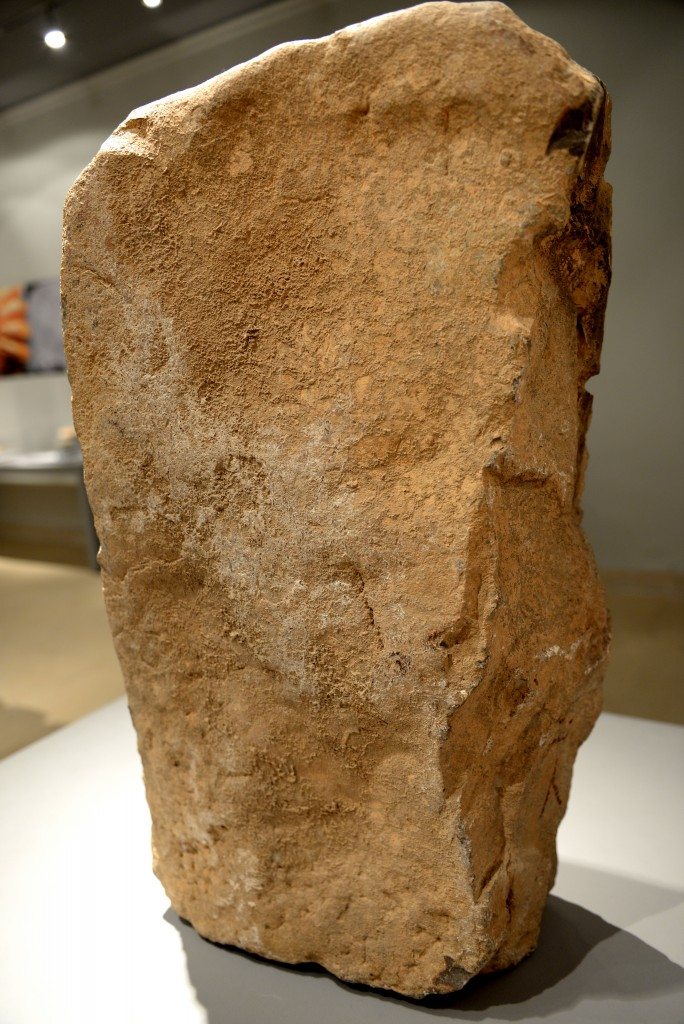Osama Shukir Mohammed Amin sets out on a detective journey to discover the mysterious history of Iddi-Sin’s stela in Iraqi Kurdistan. Going back into this region’s troubled past, he disentangles a family dispute and discovers what really happened to this exquisite artefact.
I posted a picture on my personal Facebook page of what is commonly called “the rock of the Martyr Ghareeb Haladiny” (Kurdish: به ردي شه هيد غه ريب هه له ديني; Arabic: صخرة الشهيد غريب هلديني), which depicts a limestone stela of Iddi(n)-sin, king of Simurrum. Shortly after, one of my friends phoned me. He was very upset. He said that the “title” of the rock with respect to Martyr Ghareeb is wrong and that the rock was found by local people of the village of Qarachatan, and that Martyr Ghareeb had nothing to do with the rock. “They have altered the stela’s history and ignored the role of people of the village of Qarachatan, who found and protected this rock for 15 years,” he said.
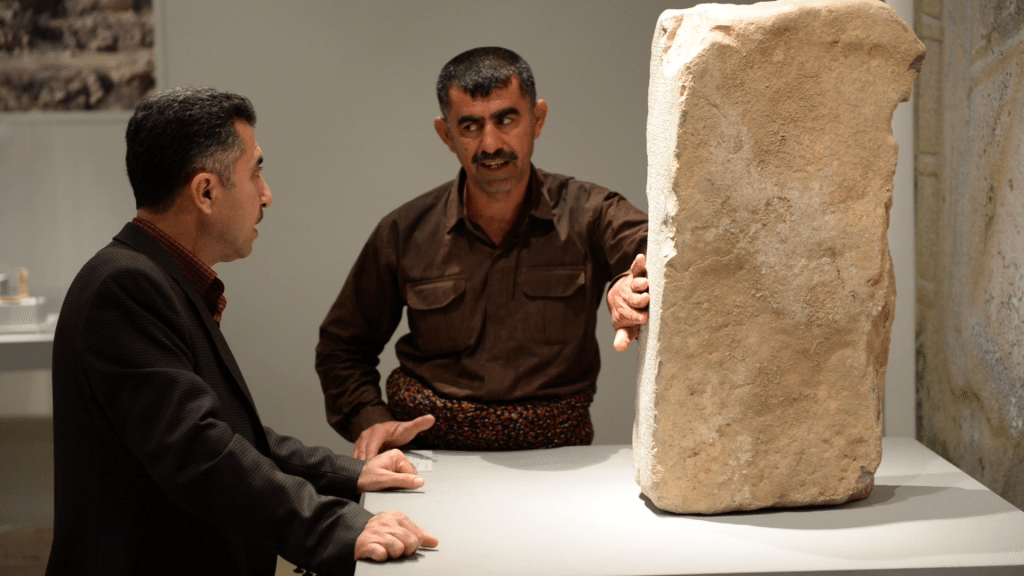
Interviewing Mr. Nejem-Alddin Ahmad (who stands between the stela and Mr. Hashim Hama Abdullah, the director of the Sulaymaniyah Museum. Photo © Osama S. M. Amin.
A few days later, I met with Mr. Hashim Hama Abdullah, the director of the Sulaymaniyah Museum (Sulaymaniyah Governorate of Iraqi Kurdistan), where the stela is currently housed and displayed to the public. I told him what my friend said. He replied: “Yes the matter is complicated and the rock has passed through very turbulent times. It is a long subject that we have not uncovered its root till this moment. Many rings of its chain are still lost. Some people from Qarachatan village claimed that they did find and store the stela.”
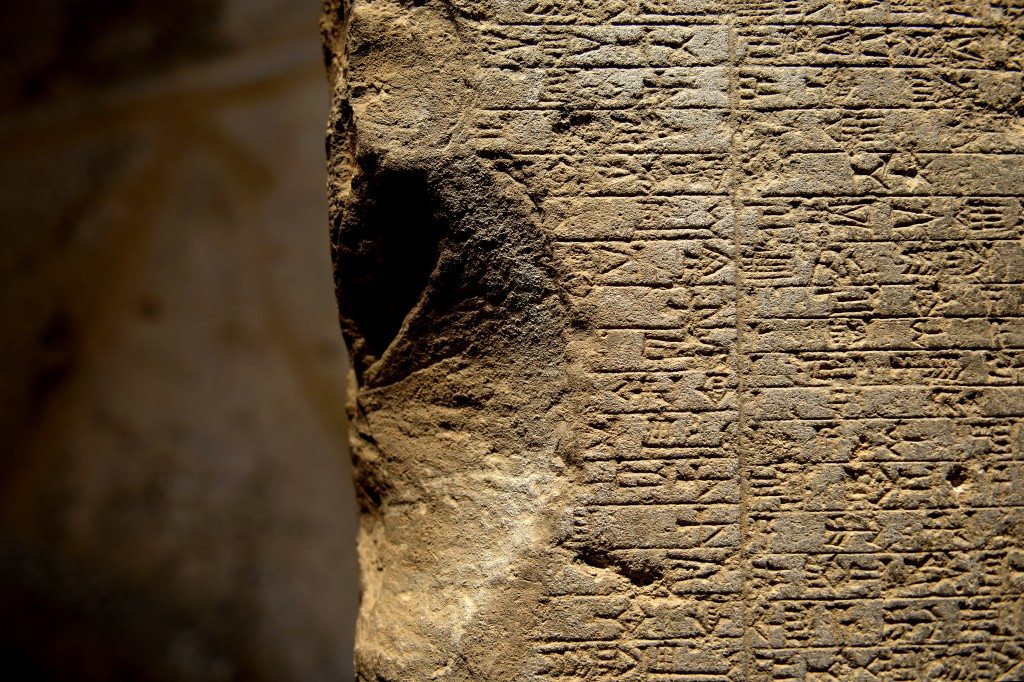
The right edge of the stela. The edge has been broken and a large fragment has been lost. This has resulted in a large lacune; the cuneiform signs at the beginning of the lines have been lost. March 30, 2015. Photo © Osama S. M. Amin.
“OK, let’s uncover the truth,” I suggested. “Let’s go there and meet the people who have any information about the stela.” Mr. Hashim replied positively and phoned Mr. Nejem-Alddin Ahmad, one of the Museum’s employees. Mr. Nejem-Alddin still lives in Qarachatan village and is the guard of the rock-relief of Rabana (mountain Rabana looks over the village and the relief lies on the cliff of that mountain, about 3-4 Km far from the village).
After about 10 minutes, Mr. Nejem-Alddin joined us at the main hall of the Sulaymaniyah Museum, where the stela is displayed. It was April 1, 2015. He stated (in response to my serial questions):
As far as I remember, it was the year 1978 or 1979 CE. Mr. Hama Nejem and his brother Mr. Hama Raof found a rock while they were working at their farm. Hama Nejem found that one of the rock’s surfaces had some inscriptions on it. He asked a local mosque’s clerk about it; the clerk said that these are Latin words and this rock is an archeological artifact. Mr. Hama Nejem then transferred the rock to his house and kept it there. During these long years of storage, the rock was used for several purposes; for example, some modern stone blocks were arranged and put beside it so that the household persons were able to use it as a solid floor in order to pray; the other example is that one of the rock’s surfaces were used as a flat plate for feeding domestic animals (NB: later on, in an interview with Mr. Hama Nejem, he denied that the rock was used for any purpose). Many villagers knew about this rock. Several times, strangers came to the village in order to buy the rock, but Mr. Hama Nejem declined to sell it. In late 1992, three people went to Mr. Hama Nejem’s house at midnight and took the rock. They put it on tractor and handed over to Martyr Ghareeb Haladiny in his house; they delivered it to his house directly. Martyr Ghareeb’s house was not far from Qarachatan village; it was within district Pira Magroon, about 10 minutes by car.
I asked him if it is possible to visit the place where the stela was found and whether I can meet the people who found it. He did not mind; he invited us to visit his home and the rest of the village of Qarachatan. He also phoned Mr. Hama Nejem and told him that someone wants to interview him about the rock; the latter agreed.
Qarachatan, where the trace begins
April 3, 2015

Panorama view of Qarachatan village (Kurdish: گوندی قەرەچەتان), where the stela of Iddin-sin was found in the year 1978 CE. Mountain Rabana and mountain Mer Quli appear on the background, where the rock reliefs of Rabana and Mer Quli lie. Photo © Osama S. M. Amin.
Great; this Friday we will come, I replied! On April 3, 2015, I, Mr. Hashim Hama Abdullah (and his son), and Mr. Bahzad (a museum employee) headed to Qarachatan village (Kurdish: گوندی قەرەچەتان; Arabic: قرية قرجتان). The village lies about 40 km north-west of the city of Sulaymaniayh (35°44’39.72″N, 45°11’37.05″E). It took about 50 minutes by car to reach there; the road between Sulaymaniayh and Lake Dukan was crowded that day. We went to Mr. Nejem-Alddin’s house; his wife made for us a very delicious lunch. Thereafter, we went to Mr. Hama Nejem’s farm. At about 4:30 PM, we met with Mr. Hama Nejem (and his son).

Mr. Hama Nejem Nasir Rasheed stands on the spot where he and his younger brother Martyr Hama Raof found the stela of Iddi-sin in the year 1978 CE while harvesting their field. Photo © Osama S. M. Amin.
Once he saw my camera, he got irritated; it was very clear from his eye sights and voice that became anxious and furious! I immediately retreated and asked Mr. Hashim to interview him; I stood away and turned on my Nikon D610 video recording. Mr. Hama Nejem Nasir Rasheed (born 1943) said:
As if it was yesterday, look here (he was pointing out towards a spot on the farm, where the stela was unearthed). It was February 1978, I and my younger, Hama Raof (born 1960; died 1991 during a revolution against Saddam regime) were plowing the earth and harvesting green onion and sunflowers. Our tractor’s chisel bumped into a solid rock all of a sudden, near a large mulberry tree. The rock was 20 cm from the surface. It was rectangular, large, heavy, and covered with mud. We pulled it aside, a little, with great difficulty and continued our work. A few days later on, a heavy rain washed out most of the mud on the rock; we found that one of the rock’s surfaces had some writings on it. We immediately, asked our religious cleric about it; the cleric said that these are Latin words and that this rock is an archeological artifact. I, my younger brother, and my friend Mr. Akram, transferred the rock to my house using a pick-up Chevrolet car, model 1962; the house is about 30 meters from the farm.
We put the rock in one of the house’s rooms. I did not know what to do with it but I decided to keep it. During the 1980s, a Toyota Landcruiser car came to my house and men, who were working at the Taslooja Cement Factory, asked me to sell it (the factory is about 10-15 minutes far from the village and a certain western European team was constructing the factory). I declined and untill this moment, if I still have it, I will never ever sell it; it is mine and I love it, I don’t know why! In March 1988 CE, the Anfal Military Campaign started and Saddam’s army bombarded our land (and village) with chemical weapons. All of us fled the village. Qarachatan village then was destroyed and my house was not exempted.
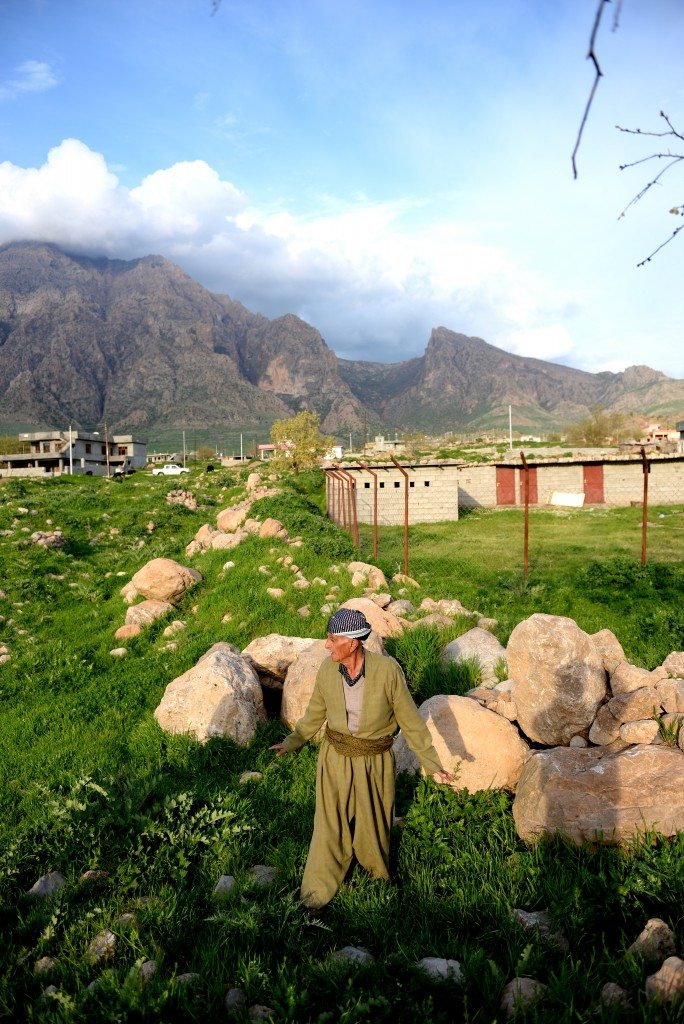
Mr. Hama Nejem describes to us how this area was destroyed during the Anfal Military Capaign in the year 1988 CE. The spot where he stands on was the room where the stela was kept for 15 years. Photo © Osama S. M. Amin.
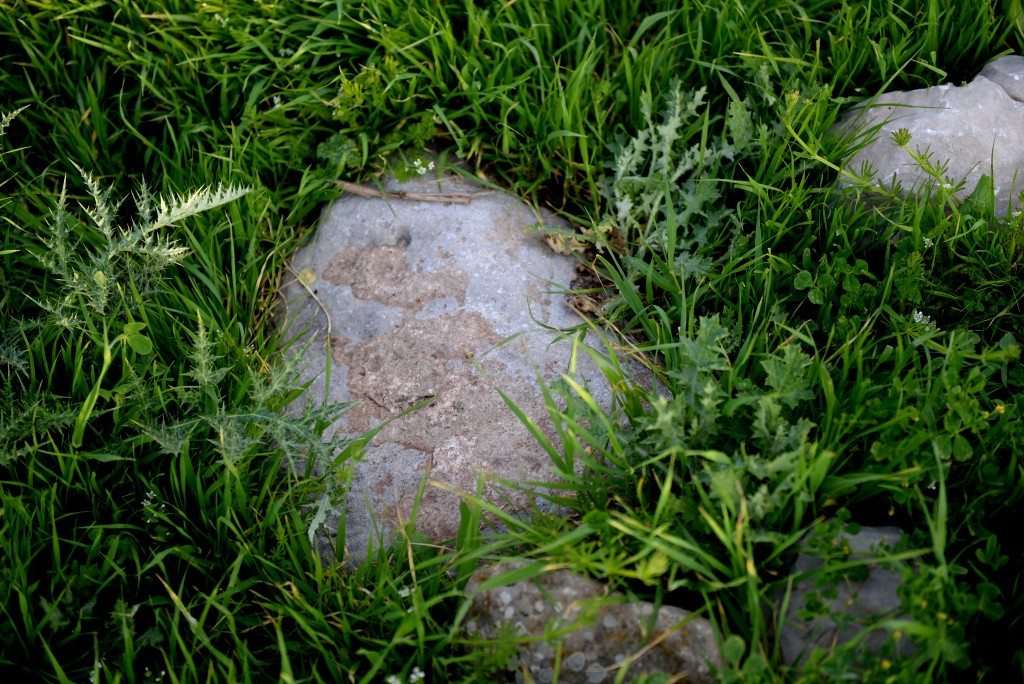
This is the precise spot where the stela of Iddi-sin was stored for 15 years. The house was completely destroyed and burned in the year 1988 CE. Photo © Osama S. M. Amin.
Hama Nejem Nasir Rasheed continued:
Nobody was able to get there. In mid-1991 CE, few months after the end of the first Gulf War (Kuwait invasion), a Kurdish revolution forced Saddam and his army to retreat beyond what is known today as the southern borders of Iraqi Kurdistan. We gradually started to re-locate and came back to our homes. I found that my house was completely destroyed and burned. What a surprise, the rock was still there, untouched, underneath a pile of stones. We gradually rebuilt our house. During the following 2 years, many people came and asked me to sell it; I declined several times (NB: at that time, Iraq was under UN economic sanctions and Iraqi Kurdistan suffered additional sanctions incurred by Saddam’s regime; e.g., with $100, you can live happily for no less than 6 months). Around that time, I got a job (driver) at the Sulaymaniyah university and left farming; therefore, I was away from the house. In December 1992, I was told that the rock was stolen by Martyr Ghareeb. Only my mother and one of my brothers were inside the house at that night.
I returned home and went to Martyr Ghareeb’s house (NB: in reply to my question of how did he know that the stela was stolen by Martyr Ghareeb; he said that people told me that a local TV aired a program about this stela and that Martyr Ghareeb said on that TV program that he delivered it to the authorities). Martyr Ghareeb declined that he had stolen the stela; I confronted him and said to him that many people saw the program on Gale Kurdistan TV. Martyr Ghareeb asked me to calm down and he offered me water, tea, and pomegranate but I refused to eat or drink anything (NB: in local traditions, if a guest refuses to eat/drink, this means that he/she comes not for a friendly visit, but to express his hostility). I told him that he had stolen a martyr’s house and his friend’s house. Then, I left his home and the next day, I decided to appear on Kurdistan TV to uncover everything. But, a friend of mine advised me not do this (NB: Kurdistan TV belongs to the Kurdistan Democratic Party while Gale Kurdistan belongs to the Patriotic Union of Kurdistan; these 2 parties are the main political parties in Iraqi Kurdistan. A military conflict was about to start between them a that time).
After then, I decided to talk with some officials, but unfortunately, Ghareeb Haladiny was assassinated 3 days after he delivered the stela to the authorities. I heard that he handed it over to political bureau of the Patriotic Union of Kurdistan (PUK). I was a member of the Kurdistan Democratic Party (KDP)! I could not file a complaint against PUK, the main governing party in the Governorate of Sulaymaniyah. Therefore, Ghareeb’s death had ended everything and I decided to forget the matter. Many years, later on, I heard that the rock was named “the rock of the Martyr Ghareeb Haladiny.” I got mad; if the rock has to be named, the name should be “the rock of Martyr Hama Raof,” my younger brother, who died while fighting Saddam’s army in 1991 in the city of Kirkuk. I don’t want any reward or money; I’m asking the Sulaymaniayh Museum just to re-name the rock.

I (white shirt) stand between Mr. Hama Nejem (on my right side) and Mr. Hashim Hama Abdulla and his son (on my left side). April 3, 2015. Near Qarachatan village, Sulaymananiayh Governorate, Iraqi Kurdistan. Photo © Osama S. M. Amin.
At the Museum
April 5, 2015
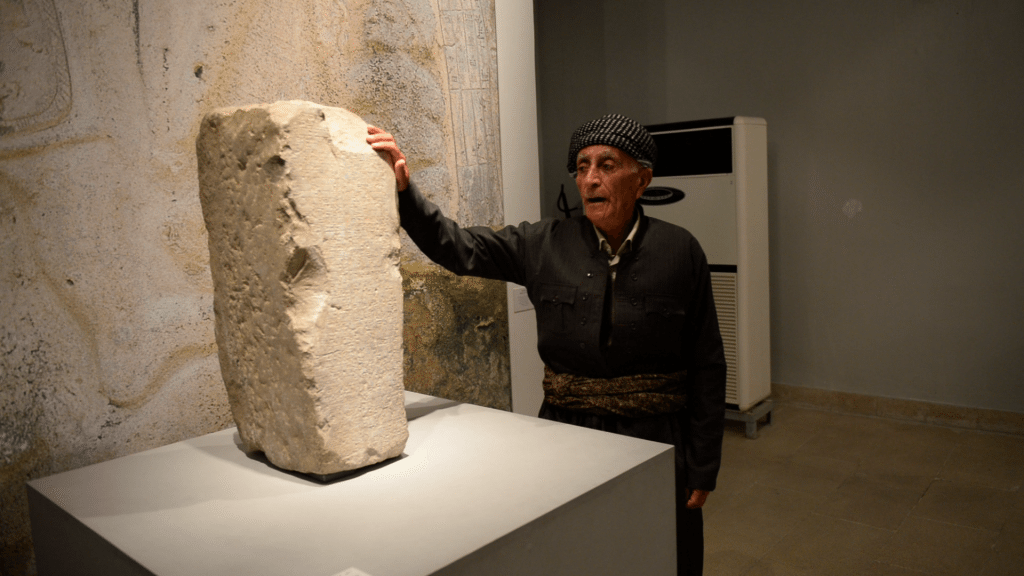
At the Sulaymaniyah Museum, Mr. Hama Nejem meets his rock after 23 years! He says that I remember the rock very well; the upper margin and right edge of the stela are damaged and lost. All margins and edges were intact when Mr. Hama Nejem found and stored the stela, excpet the a small damage at the mid-left edge of the stela. Photo © Osama S. M. Amin.
Myself and Mr. Hashim Hama Abdullah, invited Mr. Hama Nejem to visit the Sulaymaniayh Museum in order to see the stela. Mr. Hama Nejem’s could not hide his conflicting feelings. He was very happy and very angry. Some new information he provided us with. He said, “The large gap at the upper margin of the stela and the large lost piece from the right edge are new; they were not present when the rock was in my house.” He also pointed out towards many small damaged areas. He insisted that all of these damages are recent. He added:
When the tractor’s chisel hit the rock, the upper part of the stela was unearthed and the chisel stopped moving; the majority of the rock was still in the earth. The aspect of the stela where the cuneiform inscriptions were written was facing upwards. In spite of the hit, the rock was unbroken and I remember that I searched out within a diameter of 4 meters about any other pieces, but I failed to find anything else. You see how clear are these cuneiform inscriptions are? This is because I washed this rock’s side with Tide cleaner, very efficiently.
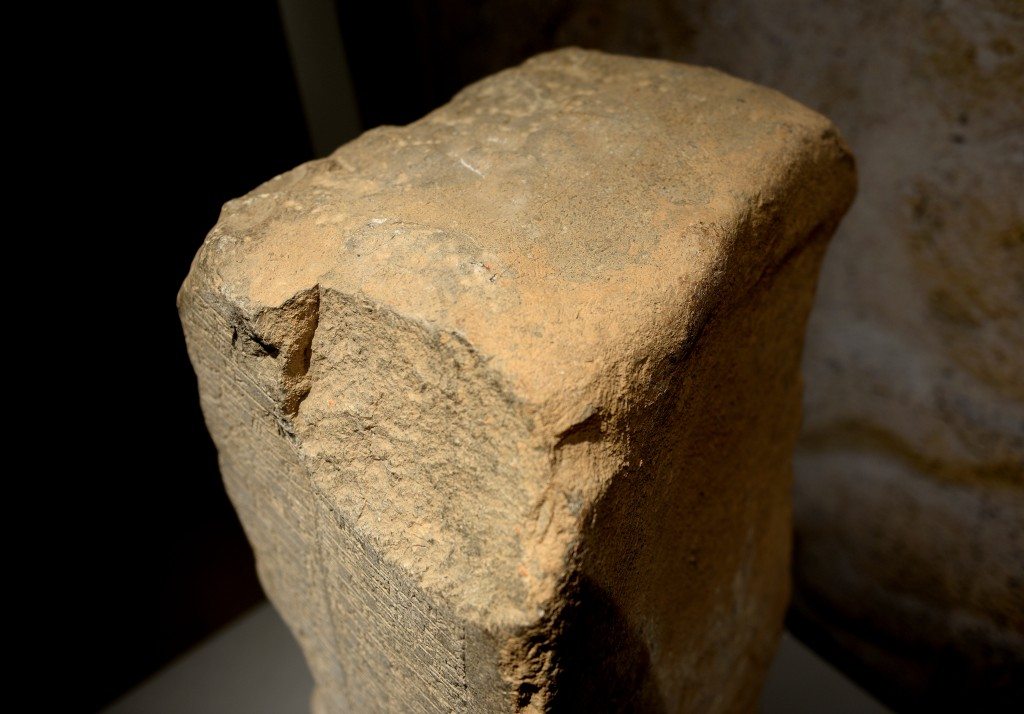
The upper/anterior part of the stela. Note that a relatively large fragment (with 5 lines of inscriptions) has been lost. This unfortunately had created a large defect within the transliterated text. March 30, 2015. Photo © Osama S. M. Amin.
I asked Mr. Hama Nejem why he did not tell the authorities about the rock when he knew that it was something ancient? He replied:
The Baath Party was in power at that time and was hostile to Kurds. During the Iraq-Iran war I hid it in order not to be in the hands of Saddam’s regime. After the Kurdish revolution in 1991 and formation of Iraqi Kurdistan Government, I and my friend Anwar Arif Qarachatani decided to give it as a gift to Mr. Jalal Talabani, in 1992 (NB: at that time, Mr. Talabani was the secretary general of the PUK). Mr. Anwar took a photo of the rock and sent it to Germany in order to know what this rock represents, but we did not get any reply. A few months later, it was stolen from my house!
I asked Mr. Hashim Hama Abdullah to arrange an interview with Dr. Kozad Ahmad Mohamad, head of the archeology department at the University of Sulaymaniyah. Dr. Kozad published (as a co-author with Dr. Rafida Abdullah Abdulsamad) an article about this stela in the year 1997. Both authors read and transliterated the cuneiform inscriptions; they were the persons who identified Iddi-sin as the stela’s owner/main figure; what a gift to the world they had presented! The article was published in the first volume (and first issue) of the the journal Hazar Merd in the year 1997; the journal was published by the general directorate of archeology/Ministry of culture of Sulaymaniyah Governorate.
The Academic Point of View
On April 6, 2015
I met Dr. Kozad; we were supposed to meet him at the Sulaymaniyah Museum at 12:00 PM, but he arrived a little late. The working-day was about to end and I had to go to my private clinic; therefore, the interview was very abbreviated yet very useful.
Dr. Kozad said:
Martyr Ghareeb guided us to the site where the stela was found in the year 1993 CE. At that time, I was one of the employees of the Sulaymaniyah Museum and gave his statement about the whereabouts and circumstances of the stela. His statement was documented in an official proceeding, which was kept in the archive department of the Sulaymaniyah Antiquities Directorate within the file of Rabana archeological site (NB: the next day, Mr. Hashim Hama Abullah took me to that archive department and the employees brought the aforementioned file. The file contained many documents, including Martyr Ghareeb’s statement about the rock relief of Rabana. However, his statement about the stela was not there; it has vanished!). Then, in the year 1997 Dr. Rafida and I transliterated the inscriptions and published the article of ‘Rock of Ghareeb Haladiny…documented reality and information’ in Arabic language (Arabic: صخرة غريب هه له دني…حقائق و معلومات وثائقية).
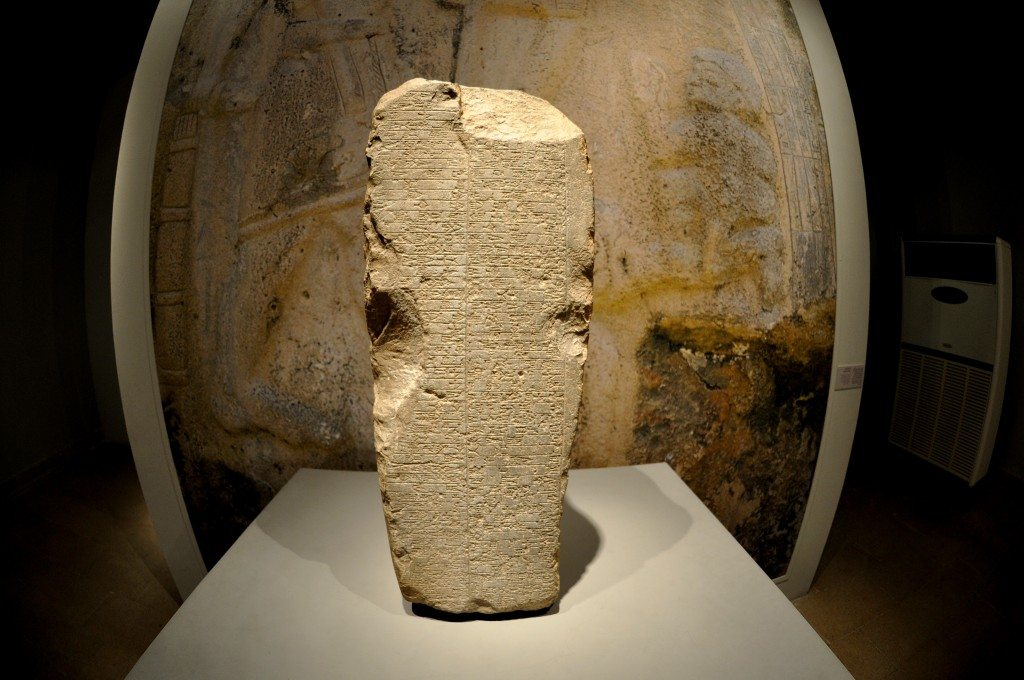
The stela of Iddi(n)-sin, king of Simurrum on display at the main hall of the Sulaymaniyah Museum, Iraqi Kurdistan. It is one of the masterpieces and unique items. Nikon D610, AF DX Fisheye-Nikkor 10.5mm f/2.8G ED lens. Shooting en face. Photo © Osama S. M. Amin.
The introduction of the article says (this is a translation from Arabic):
In the year 1993, a unique piece of archeological artifact arrived at the Sulaymaniyah Directorate of Antiquities/Sulaymaniyah Museum. Martyr Ghareeb played a very big and important role in protecting it from looters; all of those looters’ attempts failed in spite of the big sum of money they offered to anyone who would steal it and smuggle it to them. But the piece arrived safely at the Sulaymaniyah Museum, which acquired the piece under the number of 16. Because of this big story, the piece became famous among the people of Sulaymaniyah Governorate who titled this piece as ‘the rock of Ghareeb Haladiny’.
The article therefore states that it was the public, not the authorities, who named this stela. The narration continues:
In late 1992, Mr. Ahmad Hama Salih, Director of the Media Department at the PUK and Mr. Abbas Abdulrazzaq from PUK Television, stated that the first branch of the PUK has got an archeological artifact inscribed with cuneiform language and that the branch intends to give it the Sulaymaniayh Museum as a gift. The Sulaymaniyah Antiquities Directorate immediately sent 2 persons, Mrs. Rafida (the author of this article) and Mr. Aryan Omar (a professor in the College of Engineering/University of Sulaymaniyah) to have a look at this artifact, which was under extreme protection. We had been told afterwards that artifacts looters are planning to steal it and to sell it outside Iraq. After confirming its importance, drafting a preliminary report, and one year of negotiation, the artifact was delivered safely to the Sulaymaniayh Museum in less than a year.” (NB: in a later interview with Ghareeb’s younger brother, I was told that this event occurred in mid-1993, not late 1992 and there was no that negotiation).
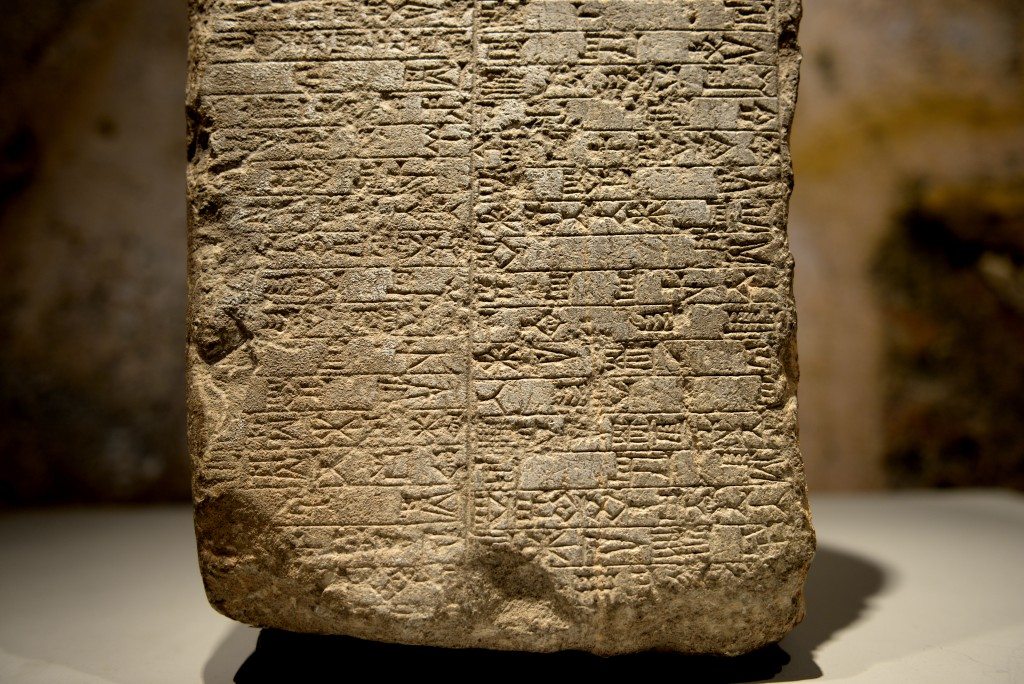
The lower part/base of the stela. Because of the damage, some cuneiform signs have been lost. The part does not contain the so-called the “cursing text.” This may indicate that the present stela is incomplete and that there is another part of the stela (in unknown place). March 30, 2015. Photo © Osama S. M. Amin.
The story continues (in Arabic):
Ghareeb Haladiny said that he knew about this rock in the 1980s and it was in the house of his friend, who lives in Qarachatan village, Surdash District, north-west of the Sulaymaniyah Governorate, at the road which links the city of Sulaymaniyah and Lake Dukan. His friend found it while he was plowing his farm and that the tractor chisel hit the rock. It was heavy. They knew afterwards that this is an archeological artifact and transferred it to their house in the village. The rock was kept in that house and the village was destroyed during the Anfal Campaign. The owner of the house died thereafter and the rock fell into oblivion. Martyr Ghareeb kept its secret and shared it with a very small number of his close friends; in the year 1992 they decided to uncover it and they told Mr. Ahmad Hama Salih about it, who then contacted the Museum. According to the law, no official or semi-official organization or any person, but the directorate of antiquities, has the right to possess any archeological artifact.” (NB: in a later interview with Ghareeb’s younger brother, the later said that they took the rock from its place in that house wreckage in March 1993).
Dr. Kozad did an extensive research about the history of Kurdistan: The Beginnings of Ancient Kurdistan (c. 2500-1500 BC), A Historical and Cultural Synthesis. The research is unpublished but can be downloaded from Academia.edu here. The story behind the discovery of the rock was mentioned as a footnote on page 255. I quote it (en bloc, in English):
The slab was discovered in the early 1980s. At that time the region where the slab was discovered was out of government control, so the discovery remained a secret until a former Pēshmarga warrior, Mr. Ghareeb Haladiny, became aware of it. Mr. Haladiny negotiated with the discoverer of the slab to reach an agreement about keeping it safe. Before they finished their preparations, the village, together with another 4500 villages, was demolished in furtherance of the Anfāl operations, started in 1987 (NB: the Anfal Campaign started in March 1988, not in 1987) by the Iraqi regime of the time against the whole Kurdish countryside. The house where it was being kept was ruined and its owner and his family disappeared. A couple of years later Mr. Haladiny was back in the region with a handful of comrades to prepare for small-scale attacks and raids against the troops of the regime. Secretly he excavated the slab from the rubble of the ruined house and transported it to a safe place until the uprising of 1991 broke out in Kurdistan. Only in 1993, when conditions had calmed, did Mr. Haladiny announce the discovery of the slab and presented it to the Museum of Sulaimaniya.
Importance of the Stela
All this intrigued me even more. I said: “Let’s go back to the Stela itself! What does the stela represent and what it has added to the literature?” Dr. Kozad summarized the importance of the stela for me:
- The stela’s narration is one of the very few inscriptions which were documented by people who resided within what is known today as Iraqi Kurdistan. The usual story was that the invaders, who came from other regions, near or far, were victorious and wrote the history. This is the only piece of evidence written by the indigenous population of Kurdistan.
- The stela very clearly mentions the name of Iddi-sin, king of Simurrum, as the owner of the stela and the victorious leader who defeated, destroyed, and subjugated several cities, through many military campaigns. Each and every city was mentioned clearly. The names of these cities were previously unknown (they lie in modern-day north-west of Iran and north-east of Iraq).
- The name of the Lullubian king Annubanini was written in the inscriptions. This proves that Annubanini was either contemporary of, or less probably older than, Iddi-sin.
- The story says that Iddi-sin had stopped the invasive wave of the Amorites and that he forced them to go back beyond his territories. This is the very first evidence of clashes/conflicts between the Amorites and the Simurrians, who both cooperated for a long time against Ur in southern Mesopotamia.
- No “curse formula” was found on the inscription. This means that the inscription originally consisted of two or more slabs, bearing a longer text, with the curse formula inscribed on the second slab. In addition, this suggests that the slab(s) was probably placed beside a relief (similar to Bitwata relief of Iddi-sin which is housed in the Israel Museum).
Meeting with martyr Ghareeb’s family
April, 18 2015
Finally, I was successful in contacting Martyr Ghareeb’s widow. After seeing all my patients, I left my private clinic at 9:03 PM. Mrs. Ghareeb, via mobile phone, gave me the directions on how to reach their home. Finally I was there and met a very humble and nice family: Mrs. Ghareeb’s widow, Ms. Kalaw Ghareeb Haladiny (archeology student at the Sulaymaniyah University) and Mr. Mohammad Haladiny (Ghareeb’s younger brother) greeted and welcomed me. I entered their home and sat in the guests room. They brought me hot Kurdish tea and fruits. Nice!

Me, sitting between Mr. Mohammad Haladiny and Mrs. Ghareeb Haladiny, at Martyr Ghareeb’s house. 10:53 PM, April 18, 2015. iPhone camera. Photo © Osama S. M. Amin.
In order not to influence their reactions and replies, I did not tell them that I had previously interviewed other people. Mr. Mohammad Haladiny was a Peshmerga also and was an attendant/guard of his older brother Ghareeb. Mohammad said this brother Ghareeb, may he rest in peace, told him:
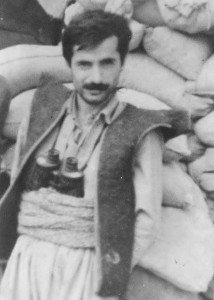
Mr. Ghareeb Haladiny, born 1956 and assassinated 1993. He was the commander of one of the Patriotic Union of Kurdistan Peshmerga forces, who fought the dictatorship of Saddam Regime. In this picture, he is wearing the traditional Kurdish dress and holds military binoculars. He seems to stand in one of the Peshmerga’s garrisons. Date of the picture is unknown. Courtesy Mrs. Kalaw Ghareeb Haladiny.
I saw the rock for the very first time in the year 1983 CE while visiting a family in Qarachatan village. The rock was on the floor in a yard, was covered with salt and vegetables. Goats and sheep were eating vegetables on this rock (NB: this is consistent with Mr. Nejem-Alddin statement above; Mr. Hama Nejem denied this). The shape and geometry of the rock was strange and drew my attention. I found some signs on one of the rock’s aspects. I immediately knew that this rock is an archeological artifact. I told the house owner that this represents something unique. They replied that this is a good-shaped rock and is very useful for their farm work and they mocked at me. I kept this secret and tried not highlight the subject.
I visited them every now and then to be sure that the rock is safe (and not sold!). In March 1988 CE, the Anfal Military operation and chemical attacks by the Saddam Regime destroyed the village completely and all of the villagers fled their houses. I and my military Peshmerga unit fled to a safe place on the Iranian border. We came back to the area in October 1988 CE, after the Anfal Campaign had ended and the Iraq-Iran war came to an end after 8 years of conflicts. Several days later, I went to the village, secretly, just to check out the rock’s house. The house and the village were completely destroyed and there was no single family living there. But I found the rock within the wreckage. It was very heavy and I could not do anything. I put more blocks and mud on it to cover it. I went back to my Peshmerga unit. After the Kurds’ revolution against Saddam in 1991 CE, Saddam’s army retreated. Kurdish people gradually started to return to their villages and homes. I once again checked out the rock and it was still there!
After a short pause, Mr. Mohammad continued:
In March 1993 CE, all of a sudden, Ghareeb gave us an order to go the village. He was the commander of the Pehsmerga Brigade (belonged to the Patriotic Union of Kurdistan) at the area of Dukan and its surroundings. Myself and five others went to the village at night. One of the men was originally from Qarachatan (but not living in the village at that time). This man brought his tractor and we went to the destroyed house.
I asked how did they know the location of the house as the matter was a secret? He said:
I and very close friends went with Ghareeb to the location a few weeks before and he told us about it and asked us to keep an eye on it. Six men then carried the rock within a blanket and we headed towards Ghareeb’s house in the Pira Magron complex of houses. We put the rock with its blanket on the floor of the house’s front yard.
I asked him whether there was anyone in the house when they took out the rock? Mohammad said: “What house? It was a wreckage, totally destroyed, abandoned, no one was there, may be 3-4 families returned to the village in scattered semi-houses.” I asked him once again, precisely, whether any person of the original house was living in or near the house where the rock was located? He replied and said: “No, no one was living there, it was not a house, only a pile of broken stone blocks, outdoors.” I also asked him about the margins of the rock. He said they were only small and minor damages at the front edges. I showed him a recent pic of the rock; he said that all of these damages are new and were not present when he and his fellow men took/transferred/delivered the rock.
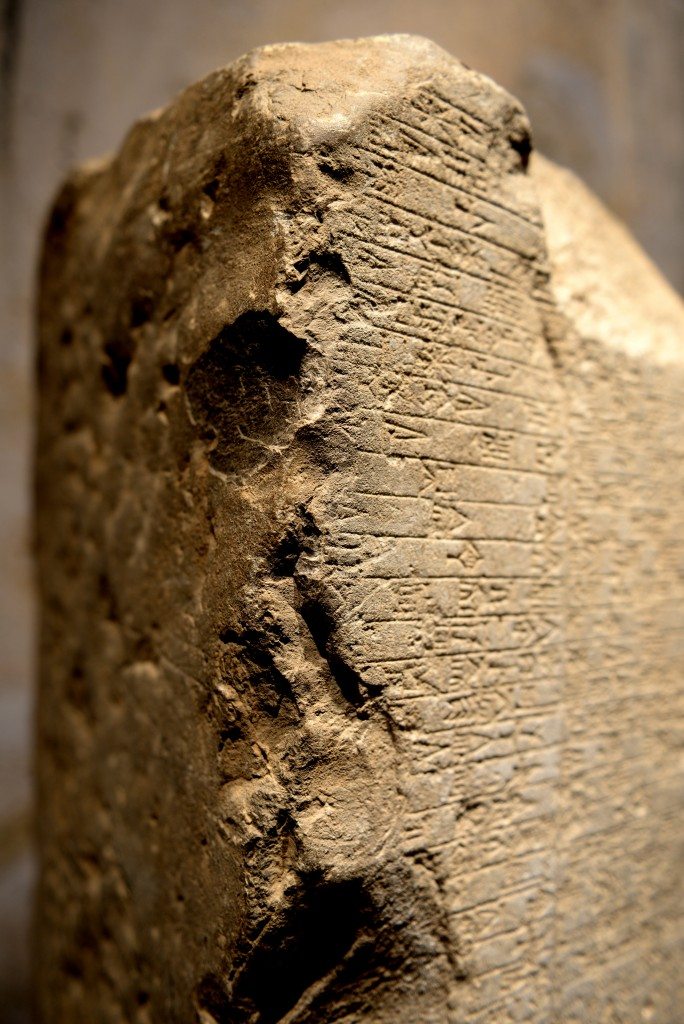
The upper part of the right edge. Note the new damages (one of them is very clear and has imparted a different color). Photo © Osama S. M. Amin.
The rock had now reached Martyr Ghareeb’s house at night. Mrs. Ghareeb Haladiny (Fatima Abdullah, Ghareeb’s widow) said:
I remember it was early Spring, March 1993. It was a cold night. A number of men brought something to Ghareeb, RIP, and went out. It was a strange-looking rock wrapped with a blanket. The weather was cold and we had no single blanket at home. I said to him, “Thank you God, a blanket, let us use it.” Ghareeb said no, this blanket is to protect this rock, not us or the children.”
The next day, a strange man visited us. He was a smuggler of archeological artifacts. He offered Ghareeb 400,000 Iraqi Dinars (today that equals to $400.000 US Dollars). Ghareeb got angry and told him to leave his house, or else he will arrest him. Ghareeb told me, because of his security post, that some smugglers heard about the rock at Qarachatan village and were then planning to steal in to sell it to merchants in Iran. That’s why he ordered some men at his unit to bring it immediately, to keep it safe. After less than a month, in April or May 1993, Ghareeb and a friend of his (known as Abbas Video), informed the Sulaymaniyah first branch of the Patriotic Union of Kurdistan in order to make the necessary arrangements to deliver the rock to the Sulaymaniyah Museum. Gale Kurdistan TV interviewed Ghareeb about the rock in May 1993; it was a very short interview. Ghareeb met some scholars from the Sulaymaniyah Museum and he took them to the spot where the rock was hidden and found, at Qarachatan village. He also took them to the rock relief of Rabana (Ghareeb Haladiny found the rock relief on a cliff of mountain Rabana).
Ghareeb loved archeology very much. From 1976 to 1991, he was a member of the Patriotic Union of Kurdistan and a then commander of one of the largest brigades of Peshmerga. Those Peshemrga were living in mountains (to fight Saddam) and they moved and relocated themselves every now then (according to the military operation and Iraq-Iran clashes). During these long years of strife and struggle against dictatorship, he and they discovered many archeological sites in Sulaymaniyah Mountains. He told me that I know the places of 6 ancient caves high up in the mountains, some of them contain potteries, utensils, and many things. I told him to bring them home and to use them (NB: the economic situation at that time in Iraqi Kurdistan was very terrible because of the UN economic sanctions and and additional sanctions incurred by Saddam on the Kurds). Ghareeb declined and said these belong to the people of Kurdistan. Ghareeb was supposed to take scholars and officials from the Sulaymaniyah Museum and Directorate of Antiquities to these cave to document these caves officially. Some men from a political party told him and threatened him to deliver the rock to them. He declined. On July 22, 1993, he was assassinated, just 3 days before the date when he was supposed to take the Sulaymaniyah Museum scholars to these caves.”
Unfortunately, no one still today knows where these cave are located and the secret was buried with Ghareeb). I asked her if anyone paid them a visit to their house claiming that he is the owner of the rock and that it was stolen from his house? She replied that nobody had come. I asked her a leading question: “Did Mr. Hama Nejem visit your house few days before the assassination of your husband?” She said: “No and I have not heard this name before.” I asked her if she knows Martyr Hama Raof? “No,” she said. I asked her if the Government recompensed Mr. Ghareeb, or gave them any form of a gift or a awarded them anything? No, she said.
I thanked them for their extreme hospitality and left the house at 11:20 PM.
My Conclusion
After these interviews, in addition to many phone calls to persons who were, in some way or another, part of the story, I made my conclusion:
- Mr. Hama Nejem and his younger brother did find the rock in their land while plowing their farm. They did not know what did this rock represents and for years; the rock was part of their farm equipment. Until 1988, they neither sold nor gave the rock to anyone, and this supports the theory that the rock was meaningless to them. From 1988 to 1993, their house was destroyed and they were not living there (neither in the house/farm nor in the village). The rock was within the wreckage of the house until it was taken out by Martyr Ghareeb’s men.
- Mr. Ghareeb Haladiny was an honest man, brave man, a man of honor, and a man of his word. He loved Kurds and was extremely patriotic and faithful to the Kurdish case. In spite of reaching a high-ranking post, his house, was very simple; the house did not contain a refrigerator, bottled gas, and enough food and even enough blankets for his children. Many people I interviewed confirmed this. Accordingly, he would never have canceled out the role of Martyr Hama Raof (if this was true) or stolen the rock from the latter’s house.
- All of the people I interviewed (apart from Mr. Hama Nejem), stressed the fact that in 1993 CE, Qarachatan village was destroyed, only few people returned to village, and the house/farm of martyr Hama Raof was destroyed and no one was living there.
- I concluded that because Martyr Ghareeb was a Peshmerga commander, responsbile for the security of the pertinent area, he must have received information that some people are planning to steal the rock and sell it to dealers outside Iraq. This explains his rapid and sudden order to his men to go and bring the rock immediately at that night.
- Many people, after the rock was aired on local TV, Gale Kurdistan, claimed that they found the rock and that they want a financial award without providing any evidence. Martyr Ghareeb took six photos at the time he delivered the rock to the authorities as a documented event; I was not able to get these pictures, they just vanished!
- The assassination of Ghareeb Haladiny created a critical gap and a lost ring in the chain of this story. Anyway, he was the one who “protected and delivered it to the authorities.” The stela should hold his name (i.e., the rock of martyr Ghareeb), but the people who found it in the first place should be credited as the stela’s initial finders and owners.
- From 1993 to 1997 CE, many margins of the stela were damaged. By whom, when, and why? And, where are these pieces? One of the pieces is relatively large and contained five lines of cuneiform inscriptions. Dr. Rafida and Dr. Kozad did not know this when they transliterated the rock in 1997 and then published the article about the stela. It was a new fact to Dr. Kozad.
- The stela’s inscriptions and narration have changed a lot and added many invaluable historical and geographical information to the pertinent literature.
I have the honour to be the first and only photographer of it, who shot innumerable pics (including very close-up images and from all angles), and and published them through Ancient History Encyclopedia, Facebook, and other social medias. No one else has done this to date. The stela has been on display in the Sulaymaniyah Museum for several years and it is open to the public; no one cared! My name has been attached to it also! What an honour I have!
Translation of teh Stela of Iddi-Sin
The stela of Iddi-Sin, King of Simurrum celebrates and commemorates the victories of this King against his enemies, mostly tribes of West Iran. The stela is carved with 108 lines of cuneiform inscriptions in 2 perpendicular columns. It dates back to the Old-Babylonian period, 2003-1595 BCE.

The left edge pf the stela. Mr. Hama Nejem stated that only the small damage was present when he found the stela in the year 1978 CE. March 30, 2015. Photo © Osama S. M. Amin.
I quote this from Dr. Kozad’s paper (column I; some characters could not be displayed properly because they were copies from a PDF file and therefore I deleted them. Please refer to the original file and its link above):
- [É(?)] Ni-[iš-ba]
- [x(?)] LUGAL 9 k[u]-[li-ší]
- kí-nu-[um]
- I-dì-EN.ZU
- [LUG]AL da-núm
- [LUG]AL Si-mu-ri-im
- NUN INANNA [x(?)]
- i-dì-šum-ma
- Ni-iš-ba
- [be]-el-šu
- [kak(?)]-kà-am
- [da]n(?)-na-am
- [t]e-e-n e-eš …
Translation:
- [Temple(?)] of the god Ni[šba]
- [temple(?) of] the king of the nine provinces
- the firm one.
- Iddi(n)-Sîn,
- the mighty [kin]g,
- [kin]g of Simurrum,
- the prince of Šauška/Ištar.
- Nišba
- his [lo]rd
- gave him
- a [mi]ghty
- weapon.
- The [pe]ople(s) of …
[embedyt]http://www.youtube.com/watch?v=NSkonFXcgHk[/embedyt]
I hope I have been unbiased towards any part/person mentioned in this investigation, and I hope that I have been helpful in delivering this story to you. This great stela unfortunately has not been highlighted until this moment and has not reached the rest of the world, in spite of the great information it has about this great king of Simurrum. The pertinent literature is already scarce about Iddi-sin. The door is now open and easily accessible to anyone who wants to get more information about this stela.
Aftermath of this Investigation
Because much new information has been uncovered for the very first time, the Sulaymaniyah Museum will be starting a new project to excavate the area where the stela was found at Qarachatan village. In addition, a summary of the history of the stela and its transliterated inscriptions will be added and put on display near the stela at the Sulaymaniyah Museum.
Many thanks go to Mr. Hashim Hama Abdullah, director of the Sulaymaniyah Museum; without his kind help and unlimited and continuous support, this article would have not been accomplished. I have heard from Jan that we have more than million visitors per month! I wish I have played a useful and honest role in delivering the Mesopotamian history and heritage to the rest of the World, via this great website of AHE. I send million greetings each month to our visitors and wish them the best! Thank you for letting me be part of this wonderful world of archeology! I really enjoyed it!
Additional Photos
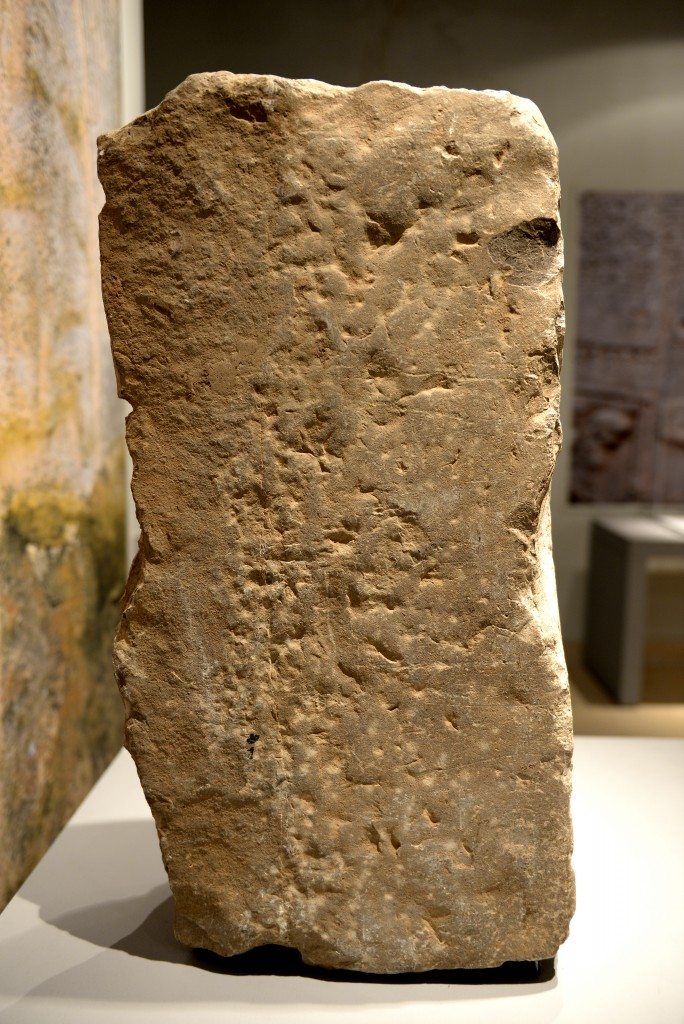
The right surface of the stela. Two men told us that this surface was used as a plate to feed farm animals; Mr. Hama Nejem declined this. March 30, 2015. Photo © Osama S. M. Amin.
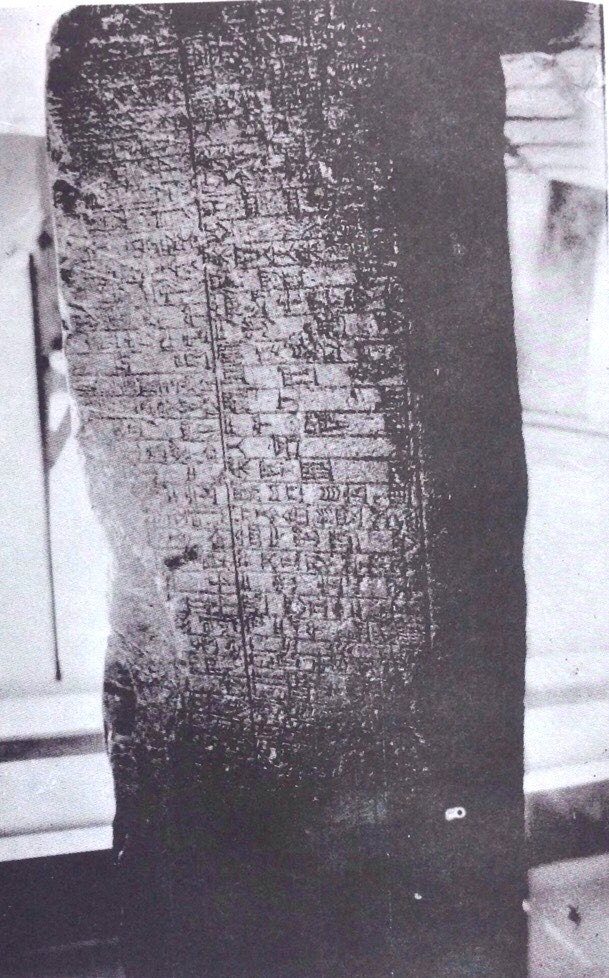
Black and white photo of the stela; date of the photo and its place are unknown. Note that the upper margin of the stela was still intact, but the right edge was damaged. The left edge seems to be intact. Photo courtesy Mr. Hashim Hama Abdullalh; no one has noticed these new damages until Mr. Hama Nejem highlighted the “recently” broken areas. Photo © Osama S. M. Amin.
